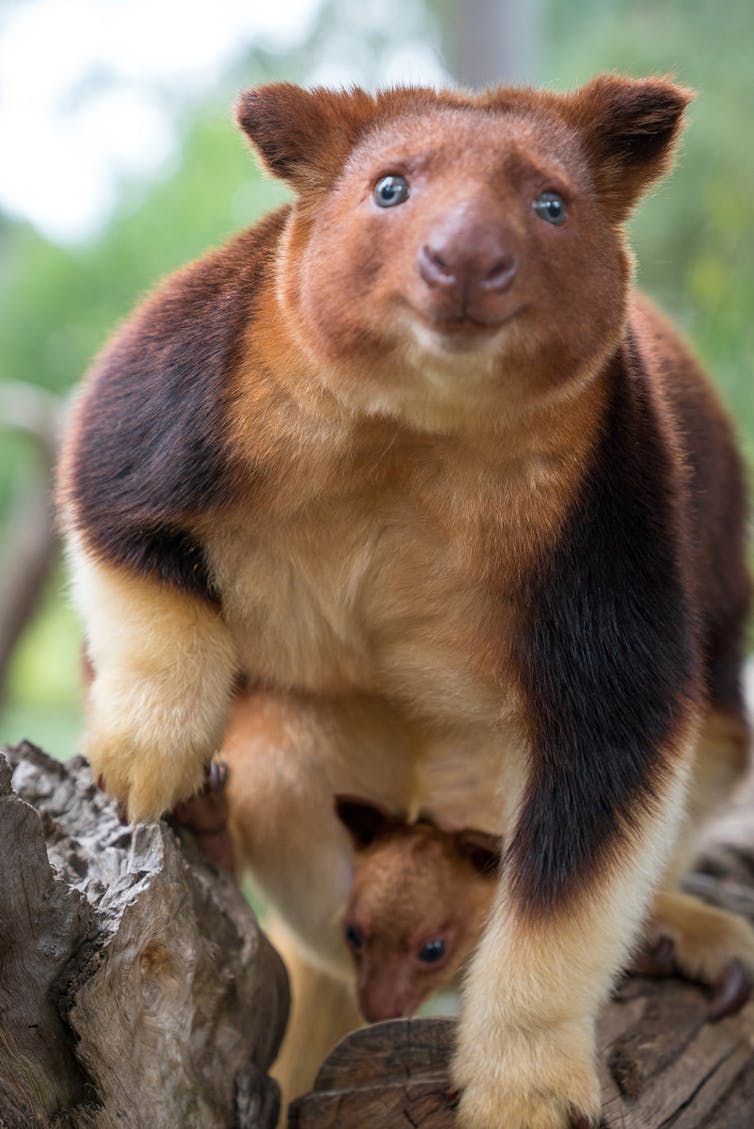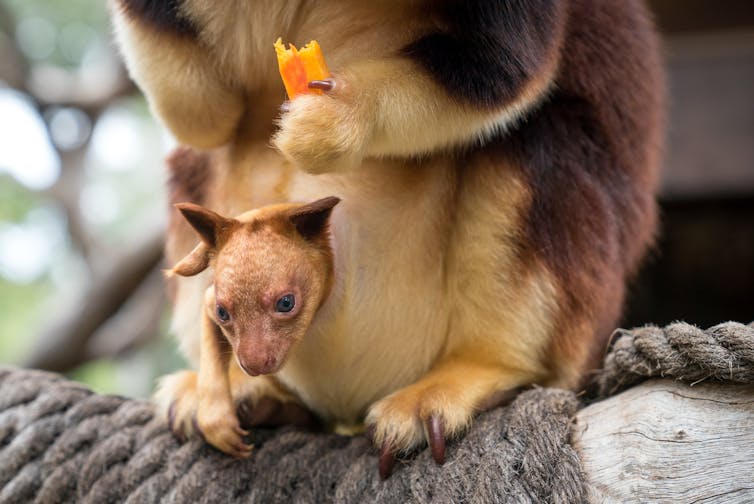Meet Chimbu, the blue-eyed, bear-eared tree kangaroo. Your cuppa can help save his species
- Written by Marissa Parrott, Reproductive Biologist, Wildlife Conservation & Science, Zoos Victoria, and Honorary Research Associate, BioSciences, University of Melbourne
Tree kangaroos are so unusual that when Europeans first encountered them in Australia in 1872, they were sceptical. Who would believe a kangaroo could climb a tree?
But the recent birth of Chimbu – a Goodfellow’s tree kangaroo at Healesville Sanctuary – gives us the chance to watch one of these unique, and very rare, creatures grow up.
Read more: In the remote Cambodian jungles, we made sure rare Siamese crocodiles would have enough food
The Goodfellow’s tree kangaroo is a threatened species found in forests in the Central Cordillera mountain ranges of Papua New Guinea, from sea level to high in the clouds.
Chimbu’s birth in September is the latest success of a complex web of international conservation. Zoos and other organisations around the world transfer and match tree-kangaroos to avoid inbreeding and sustain a genetically healthy captive population.
Chimbu is named after an area in Papua New Guinea where his wild cousins live.A climbing kangaroo? That’s roo-diculous!
Europeans in New Guinea first described tree kangaroos in 1828. While there have been plenty of disagreements about who is related to whom, we now know there are 14 distinct species.
Early explorers considered the very idea of a climbing roo ridiculous, but these animals are specially adapted to life in the trees. They likely all evolved from a terrestrial ancestor earlier in the Pliocene, 5.3 million to 2.5 million years ago.
 Tree kangaroos look like marsupial bears, but can climb trees like monkeys.
Healesville Sanctuary, Author provided
Tree kangaroos look like marsupial bears, but can climb trees like monkeys.
Healesville Sanctuary, Author provided
Tree kangaroos have much longer forelimbs than their ground-dwelling cousins and their claws are much larger and strongly curved. This provides much stronger grip when climbing trees and gripping smaller branches.
They still have large strong hind limbs, but their feet are shorter, broader and have a long curved claw on each toe.
Read more: This extinct kangaroo had a branch-crunching bite to rival today's giant pandas
The pad of the hindfoot is single, large and with prominent grooves, all of which enhance the animal’s grip when climbing and walking in the canopy. The tails of tree kangaroos aren’t capable of grasping things like a monkey’s, but they’re long and often held out behind the animal for balance.
But perhaps one of the most obvious differences between tree kangaroos and their terrestrial cousins is their adorably small bear-like ears.
Threatened with extinction
Two species of tree kangaroos are found in the forests of northeast Australia and 12 species in the jungles of New Guinea. All species of tree kangaroos are threatened with extinction in New Guinea, although much about these animals is unknown.
 The current population size is unknown, but this species of tree kangaroo is thought to be declining in the wild.
Healesville Sanctuary, Author provided
The current population size is unknown, but this species of tree kangaroo is thought to be declining in the wild.
Healesville Sanctuary, Author provided
Traditionally hunted for food, hassled by dogs and threatened by the destruction of their forest habitat, the soft thud of tree roo feet among the trees is falling silent.
But conservation work in their natural habitat and through a globally managed tree kangaroo captive breeding program is helping not only the species, but the people who live alongside them.
Baby Chimbu – a new hope
Chimbu was born in Victoria, but is really an international fellow. His mother Mani came from the National Zoo and Aquarium in Canberra, and his father Bagam arriving from Kreffeld Zoo in Germany.
 Baby Chimbu brings hope to a species nearing extinction.
Healesville Sanctuary, Author provided
Baby Chimbu brings hope to a species nearing extinction.
Healesville Sanctuary, Author provided
Mani and Bagam were paired based on the recommendation of scientists and managers who maintain a studbook of Goodfellow’s tree kangaroos around the world.
These gorgeous animals are generally chocolate brown on the back, shading to pale brown or cream on the face and belly, and often with a single or double narrow pale stripe down the back.
Read more: 'Give us a sniff, love': giving marsupials scents from suitors helps breeding programs
Their beautiful striped tails are one of their most noticeable features. And while the current population size is unknown, this tree kangaroo is thought to be declining due to hunting for food, local trading for cultural purposes, and habitat destruction through local deforestation and shifting cultivation.
Managing tree kangaroos around the globe
The captive population of Goodfellow’s tree kangaroos in our region is coordinated by the Australasian Zoos and Aquarium Association.
The plan is to maintain long-term healthy populations that are genetically diverse, stable and show natural behaviours to ensure the animals are thriving in their zoo homes.
 Chimbu ventured out of his mum’s pouch to sample some tasty salad.
Healesville Sanctuary, Author provided
Chimbu ventured out of his mum’s pouch to sample some tasty salad.
Healesville Sanctuary, Author provided
In turn, the regional program is part of a global species management plan coordinated by the World Association of Zoos and Aquariums.
A key feature of these regional/global management programs is to avoid any inbreeding. Detailed histories of all animals in the population are closely managed, and suitable breeding pairs are identified by specialist zoo keepers called “Studbook Keepers”.
This is why Chimbu was born from a long-distance romance and travel by his parents.
Your cuppa can help
Supporting wildlife conservation in the wild and with local communities is the driving force for zoos globally.
 An international network of captive tree kangaroos helps conserve this species.
Healesville Sanctuary, Author provided
An international network of captive tree kangaroos helps conserve this species.
Healesville Sanctuary, Author provided
Although the Goodfellow’s tree kangaroos are officially endangered, we don’t know much about them in the wild. Right now, the Wildlife Conservation Society is working out how many are in the wild and where, so scientists can develop a detailed conservation program.
Cousins of the Goodfellow’s tree kangaroo, such as the Matschie’s tree kangaroo, are more well-known and already have conservation programs in place.
Read more: Yes, kangaroos are endangered – but not the species you think
To help save Matschie’s tree kangaroo, community programs have emerged to address the economic conditions fuelling their over-hunting. Zoos Victoria has partnered with the Tree Kangaroo Conservation Program to sell coffee grown by Papua New Guinean villagers. This helps create sustainable alternative income and fund conservation.
 Collecting coffee beans for YUS conservation coffee in Papua New Guinea.
Ryan Hawke/Tree Kangaroo Conservation Program, Author provided
Collecting coffee beans for YUS conservation coffee in Papua New Guinea.
Ryan Hawke/Tree Kangaroo Conservation Program, Author provided
Income from coffee sales generates much greater access to healthcare and education, major hurdles in these remote villages. Money from sale of the coffee beans is the only regular income into these villages.
So if you do decide to visit Chimbu at the Healesville Sanctuary (in person or virtually) remember you can also buy some coffee to help his wild cousins.
This article is co-authored by Chris Banks, Manager International Conservation, Zoos Victoria, who has worked with tree kangaroo and community conservation for over 20 years
Authors: Marissa Parrott, Reproductive Biologist, Wildlife Conservation & Science, Zoos Victoria, and Honorary Research Associate, BioSciences, University of Melbourne



